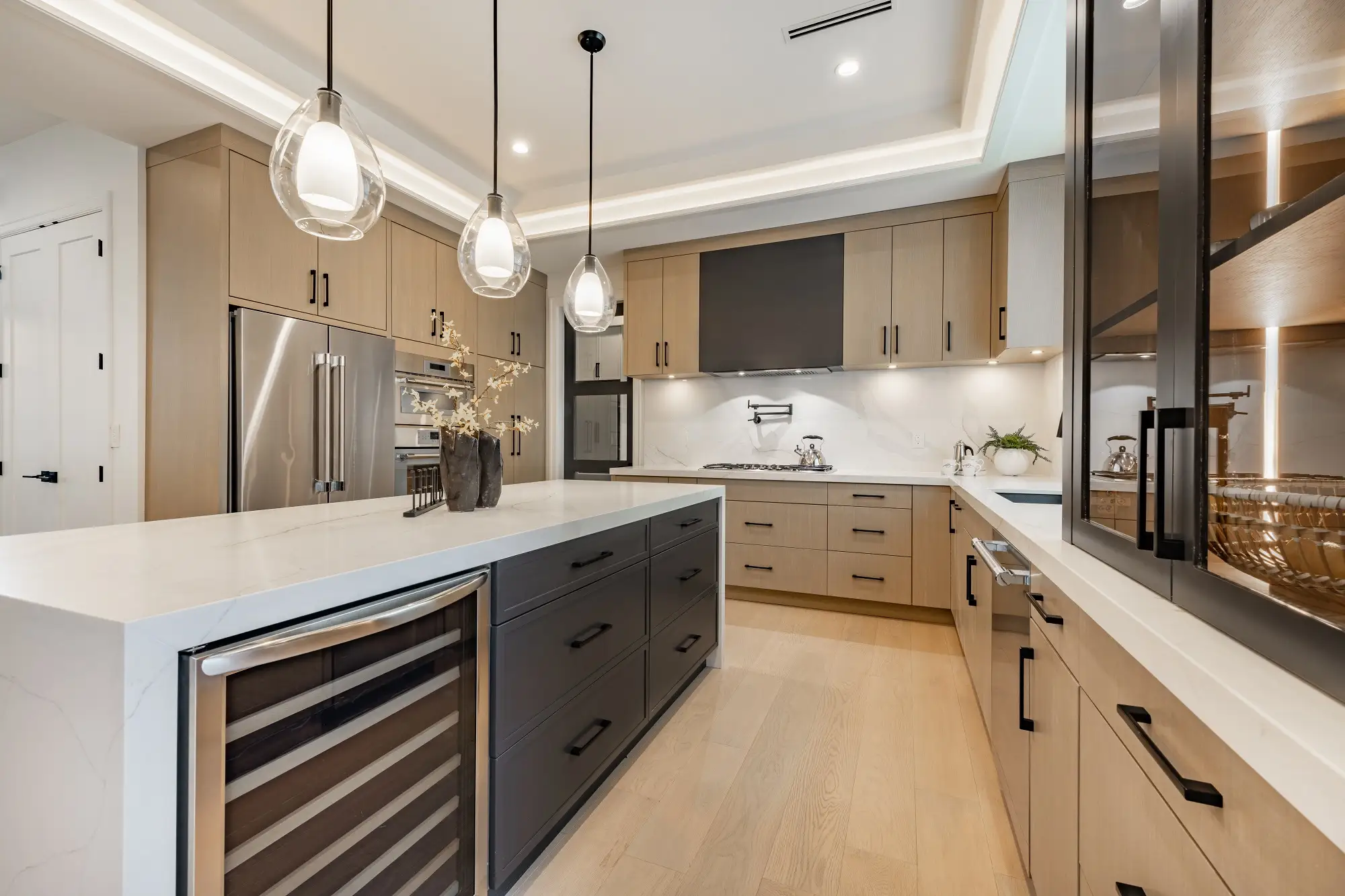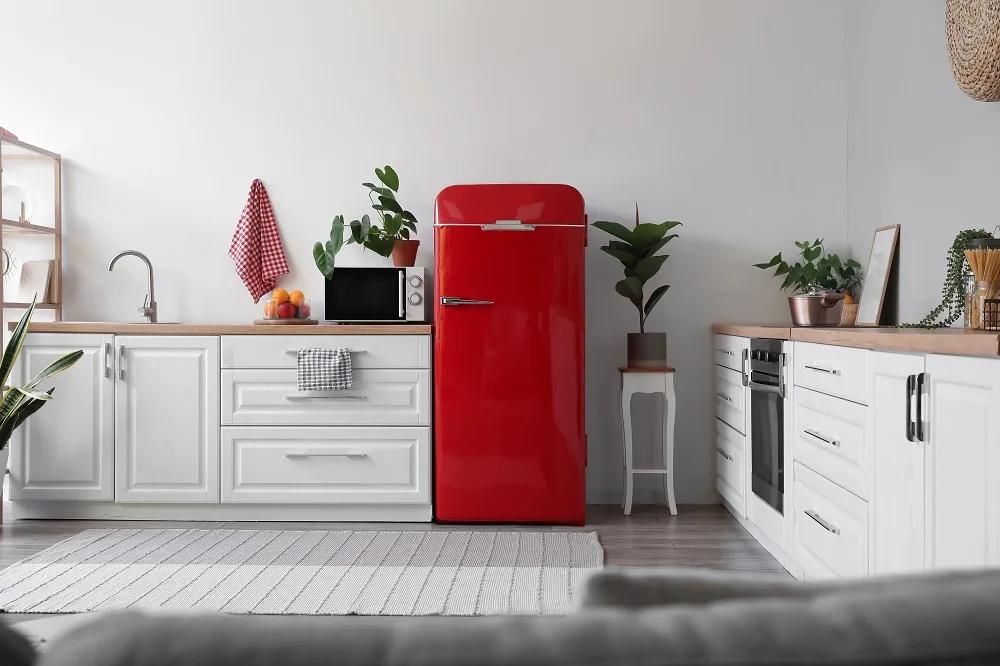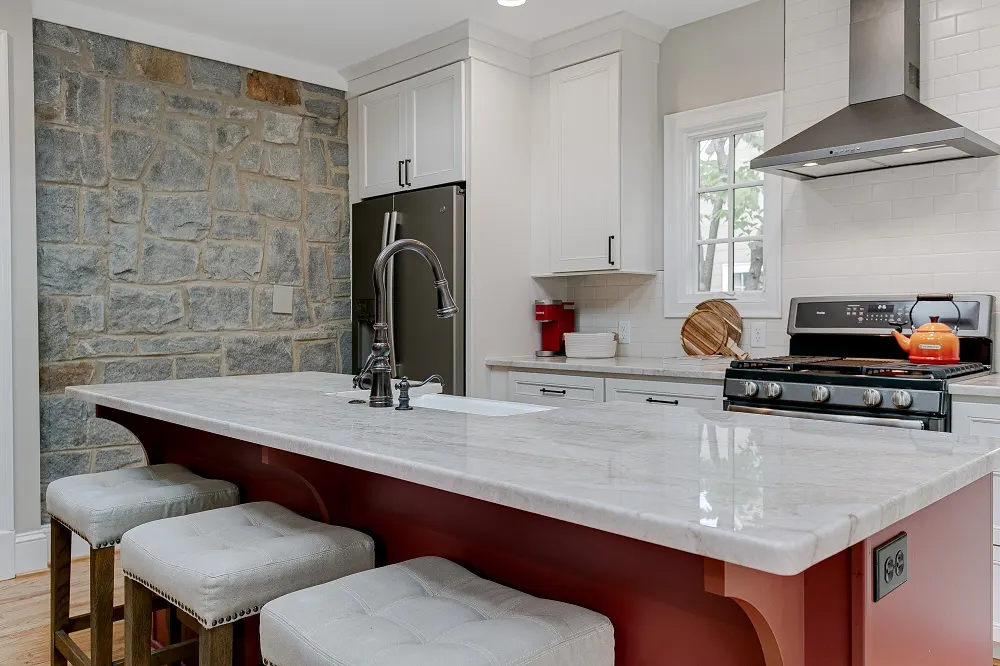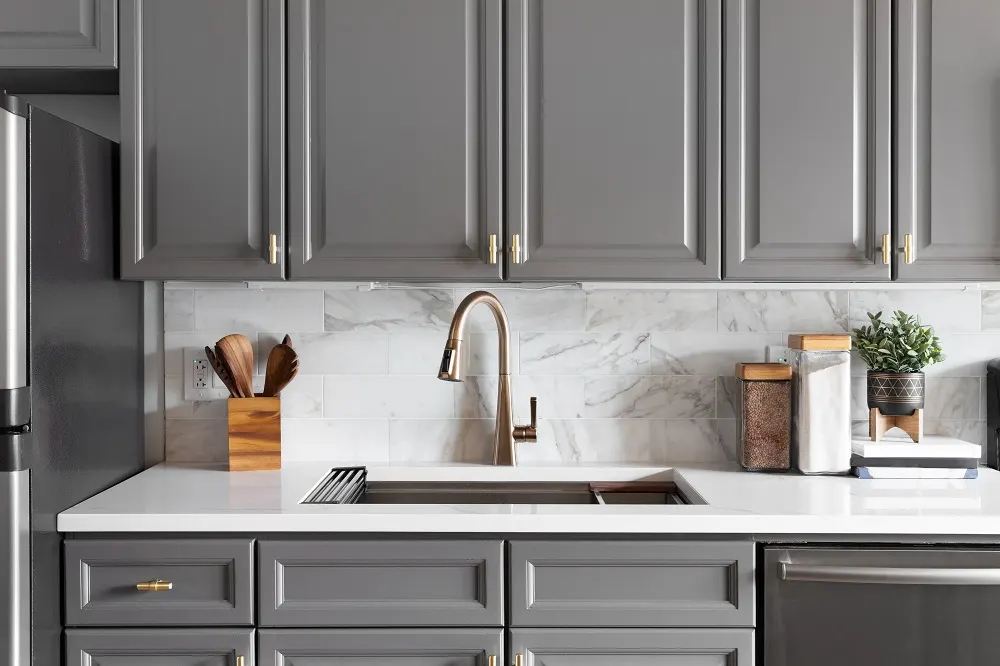
Custom Wall Paneling on a Budget: Expert Tips and Tricks
Upgrade interiors with decorative panels walls. Discover custom wall paneling costs, materials & tips from experienced Chicagoland renovation experts.











A kitchen that feels disconnected can interrupt the flow of your entire home. When cabinets clash with countertops or hardware looks mismatched, the room quickly loses both comfort and function.
Working with a reliable kitchen cabinet refacing company can refresh your space without the high cost or disruption of a full renovation. This guide shares 20 expert ideas on how to make a kitchen look cohesive, reflect your personal style, and strengthen your home’s overall design.
Cohesive design creates balance and unity, making your kitchen both welcoming and functional. When every element — from cabinet finishes to hardware choices — works together, the space feels purposeful instead of random.
A coordinated kitchen improves resale value and daily comfort. It photographs better, feels larger, and brings calm to everyday routines. Thoughtful design decisions also reduce visual clutter and create smooth transitions between your kitchen and nearby rooms.
Design professionals agree that cohesion involves more than matching colors. It means balancing textures, materials, and finishes with a consistent style. This approach transforms separate features into one polished design that reflects your personality.
One of the foundational elements in creating a cohesive design is selecting a color scheme and incorporating it throughout your home. When doing this, consider the mood and ambiance you want to create and choose colors that work well together to create the desired atmosphere.
Introduce one or two accent tones through décor such as stools, artwork, or small accessories. A restrained palette keeps the room balanced while adding character. Observe how light changes your colors throughout the day, as natural light can alter tones dramatically.
Warm colors like beige, cream, and gold bring softness and pair naturally with wood finishes. Cool hues such as gray, blue, and white create a clean, contemporary feel that matches stainless-steel appliances and modern fixtures.
Mixing both requires precision. If your cabinetry leans cool, add warmth through metal finishes or lighting. This subtle contrast adds depth and prevents the space from feeling flat.
Continue your color story into adjoining rooms for smooth visual flow. The kitchen should connect naturally to dining or living spaces. Choose complementary shades that link each area together, helping the entire home feel intentional and cohesive.

Identifying your desired interior style is another crucial step in creating a cohesive and flowing home design. Consider the most popular types of interior styles, such as contemporary, farmhouse, or minimalist, and determine which one resonates with your taste. Pay attention to the clean lines, textures, and color palettes associated with your chosen design style. Be sure to incorporate the right cabinet hardware, such as handles or knobs, to further enhance your space's overall look and feel. This small detail will add to the uniformity of the space.
Cabinet hardware acts as the finishing touch for your cabinetry, so aligning it with your overall design is essential. Modern kitchens look best with sleek bar pulls in brushed nickel or matte black, while traditional spaces benefit from classic knobs in oil-rubbed bronze or polished brass.
Hardware size and shape should complement the cabinet door design. Larger pulls enhance flat, contemporary doors, while smaller knobs fit well with raised panel styles. Keeping all finishes consistent adds a refined, unified look that elevates the entire kitchen.
Don't be afraid to incorporate multiple textures in your kitchen design as an easy way to add cohesion. Mix and match finishes like stainless steel, glass, and wood grains to add visual interest. Varying textures also create contrast and depth to make the space feel more dynamic.
Think beyond visuals and include tactile appeal. Woven bar stools, handmade tiles, or textured fabrics bring warmth and authenticity that smooth surfaces can’t match. These elements make the kitchen feel thoughtfully developed instead of overly staged.
Pair rustic and refined finishes for balanced sophistication. A reclaimed wood island can contrast beautifully with glossy cabinets, while stone countertops add softness to sleek surfaces. This blend of textures keeps the eye interested without overwhelming the design.
Limit the number of textures to three or four. Too many materials compete for attention, creating visual clutter that weakens cohesion.

When creating cohesive kitchen decor, it's important to use pieces that you truly love. Don't be afraid to incorporate items that feel like a reflection of your style and taste. Whether it's a unique piece of artwork or a vintage find, incorporating pieces you love will help create a timeless kitchen that reflects your individuality. By surrounding yourself with items that bring you joy and resonate with your design style, you can cultivate a cohesive and inviting space that truly feels like home.
Natural light can significantly impact the overall atmosphere of your home. Maximize the amount of natural light that enters your space by using sheer window treatments or opting for minimalistic window coverings. Strategically place windows to allow sunshine to illuminate your space. Choose light, neutral cabinet colors like white, beige, or gray to reflect and enhance the light. This will create a sense of openness and flow that ties all of the design elements together.

Mixing vintage finds with modern furniture and decor lends a layered, curated look to your kitchen. Aim to choose pieces that share a common thread, like walnut accents or metallic finishes, to tie the space together. Opt for vintage lighting and other decorative items that speak to the kitchen's timeless vibe. The key is ensuring the combined aesthetic feels purposeful, not haphazard. An eclectic yet cohesive kitchen comes from blending eras and styles with complementary textures, colors, and materials that align with your overall vision.
Don't forget what goes on the floors. Rugs go beyond function to help define distinct zones within your home. Select modern pieces that complement your color scheme, tying spaces together visually. Use lively patterns anchored by solid borders in open floorplans to delineate living, dining, and cooking areas. Don't be afraid to layer various shapes, textures, and materials to craft a cohesive flow from room to room. The right rugs act as anchoring design elements that provide both form and function to create a unified aesthetic.
Note: Select low-pile or flat-weave rugs for kitchens and other high-traffic zones. These materials resist stains, clean easily, and offer better traction than plush rugs, ensuring both safety and style.

To maintain a cohesive design, it's also important to consider the lighting elements within your home. Avoid mixing overly contrasting light fixtures, as this can create a disjointed and inconsistent look. Instead, opt for fixtures that share a similar aesthetic, whether it's sleek and modern or vintage and rustic, to ensure harmony.
Kitchen cabinets dominate the visual landscape, making them the foundation of a cohesive design. Cabinet door styles should reflect your aesthetic — sleek slab doors for modern kitchens or detailed raised panels for classic appeal.
Cabinet finishes set the tone of the room. Light shades create a sense of openness and make smaller kitchens appear larger. Darker tones add richness and contrast but work best when balanced with ample natural light.
Inset vs. overlay construction affects the overall aesthetic significantly. Inset cabinets deliver a refined, furniture-quality appearance while overlay styles offer contemporary appeal. Consistency in construction style throughout the kitchen maintains visual flow.
Two-tone cabinetry can enhance depth and interest. Pair lighter uppers with darker lowers, ensuring both share the same undertones or complementary hues. The result is contrast with cohesion.
Note: Cabinet refacing refreshes door styles, finishes, and hardware without replacing the cabinet boxes — offering a dramatic visual update at a much lower cost than full replacement.

Although they seem simple, white walls serve as a neutral backdrop to anchor your kitchen's design. Crisp white provides a clean slate for you to layer various textures, materials, and accents. Choose white paint with cool undertones to pair elegantly with white cabinetry for a timeless look. Keep walls bright to reflect light and make the space open and airy. You can then introduce color and personality through movable design elements like bar stools, rugs, appliances, and decor. White walls allow flexibility to redesign while keeping cohesion.
You can coordinate your furniture pieces to create a unified look throughout your space. Whether it's matching upholstery, similar wood finishes, or complementing styles, having cohesive furniture selections will tie the rooms together and create consistency. Choose furniture pieces that work well together and improve the overall design aesthetic.
Blend wood, metal, and upholstered pieces to create layers of visual and tactile interest. The goal is to maintain a common design thread — match wood tones across furniture and coordinate metal finishes between chair legs, fixtures, and cabinet hardware. This consistency ties every element together for a cohesive interior.

Your countertop choice plays a major role in kitchen cohesion. Think about how its color, texture, and pattern interact with your cabinetry. Light surfaces contrast beautifully with dark cabinets, while tone-on-tone pairings deliver a calm, continuous look.
Natural stone introduces unique variation that can enhance or disrupt your palette. Draw accent shades from the stone’s pattern to influence other decisions, such as backsplash tile, wall paint, or accessories. This subtle coordination keeps the design intentional.
Edge profiles should reflect your overall style. Straight edges complement modern spaces, while curved profiles like ogee or bullnose suit more traditional kitchens. Keep edge styles consistent across every counter to maintain visual flow.
Note: Custom kitchen designs make it easier to coordinate countertop colors, finishes, and edges with cabinetry for a cohesive finish.
Flooring is a foundational element in any interior space. Choose flooring options that align with your desired style and create a seamless transition between rooms. Whether you opt for hardwood, painted wood, tile, or carpet, make sure to select options that complement each other and create a flow.

The finishing touches in your kitchen, like barstools, dishware, and fresh flowers, help tie the space together. Opt for accessories in colors that complement your kitchen's clean, cohesive aesthetic. Choose decorative accents with clean lines that align with the overall modern style. The right finishing touches that adhere to the color scheme and design concept add that final unified layer that brings the whole kitchen to life. You can even keep things cohesive yet fresh by rotating new artwork, linens, and greenery for a more cohesive kitchen aesthetic.
Incorporating a focal point is an important element in creating a balanced design in your home. Whether it's a statement piece of furniture, a vibrant accent wall, or a striking piece of artwork, a focal point helps to anchor the design and draw attention. It adds visual interest and serves as a centerpiece for the overall aesthetic. By selecting the right design and placement for your focal point, you can create a harmonious home that reflects your style.

In creating a cohesive home with a balanced design, coordinating your kitchen accessories is key. Choose accessories that complement each other and align with your overall design theme. Keep a simple design in mind and select items that share a similar style, color palette, or material. Whether it's sleek and modern or rustic and farmhouse, coordinating your kitchen accessories will create a uniform and visually pleasing look. From utensil holders to dishware and countertop decorations, each accessory plays a role in maintaining a harmonious design throughout the entire room.
Keeping your countertops clutter-free is a vital tip for achieving uniformity in your home. Clearing off excessive items and keeping only essential and decorative pieces will create a clean and organized appearance. Embrace a minimalist approach by storing frequently used items in cabinets or drawers, leaving your countertops free of unnecessary clutter. This will not only create a more visually appealing space but also allow your countertops to feel cohesive and showcase their natural beauty.

Any interior designer knows that hanging artwork or photographs is a wonderful way to add personality and create a cohesive and balanced design in your home. Choose pieces that reflect your style and aesthetic, considering the color scheme and theme of your space. Whether it's a gallery wall or a single statement piece, artwork can tie all the elements of a room together and provide a focal point. Carefully select and arrange art to create a harmonious and visually appealing space. These personal touches reflect your unique taste and add depth to your overall design.
When creating a cohesive and balanced design, it's important to consider the display of small appliances in your kitchen. Opting for a cohesive look can enhance the overall aesthetic and flow of the space. Choose appliances that match in color or finishes, creating a harmonious and seamless appearance. Whether it's a matching toaster and kettle set or coordinating stainless steel appliances, a cohesive display of small appliances will help create a visually pleasing and well-coordinated kitchen.

Last but not least, incorporate storage solutions seamlessly into your interior design for both form and function. Many interior designers recommend that you opt for cohesive kitchen cabinets in neutral hues that blend with your color scheme to conceal clutter. Display favorite items in open shelving using coordinating boxes, baskets, and canisters for visual harmony. Floating shelves are versatile decorative storage options that will allow you to access your necessities while maintaining clean lines. No matter the style, be sure the storage elements coordinate well with other finishes and materials in your space for a polished and balanced look.
Cabinet refacing offers a smart, efficient way to achieve cohesive kitchen design without the mess or expense of a full remodel. The process updates cabinet doors, drawer fronts, and hardware while keeping your current layout and cabinet boxes intact.
Refacing vs. replacing cabinets yields nearly identical visual results at 30–50% lower cost. The job typically takes 3–5 days instead of several weeks, allowing homeowners to enjoy fast results without extended downtime.
Since cabinet refacing costs much less than full replacement, you can reallocate savings toward complementary updates like countertops, backsplash tile, or flooring. The outcome is a coordinated, custom-looking kitchen that feels fresh, balanced, and intentionally designed.

Pulling together a harmonious interior design requires intention in every choice. Use cohesive color palettes, lighting, materials, and flooring to intentionally connect each space. Craft smooth transitions from room to room by maintaining a consistent style that supports your vision. When all elements work in unity, you achieve a polished, timeless interior with a seamless flow.
Ready to give your home a cohesive makeover? The experts at Kitchen Cabinet Guys are here to help with services like cabinet door refacing. Contact us today to transform the look of your kitchen or bath with custom solutions designed to unify your style. Get an estimate today!

Schedule a free consultation and estimate with our specialist.
Call Us Now: (800) 809-7197 or
Get a Free Estimate